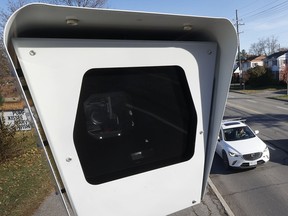World
Doug Ford Targets Ontario’s Speed Cameras as Revenue Sources

Ontario Premier Doug Ford has announced plans to dismantle the province’s automated speed enforcement (ASE) programs, claiming they serve more as a financial burden on drivers than a public safety measure. This shift comes after Ford’s government initially implemented ASE legislation in 2019, which aimed to reduce speeding through the use of speed cameras across various municipalities.
During a press conference held in Vaughan, Ford expressed his discontent with the current ASE systems, stating they have failed to effectively slow down drivers. He characterized municipal speed camera programs as “nothing more than a tax grab,” asserting that they penalize unaware motorists instead of enhancing road safety. “When you’re issuing 65,000 tickets in three months, that’s not slowing people down,” Ford stated, referencing a specific camera in Toronto that has reportedly generated nearly $7 million in fines.
The premier’s announcement included plans for legislation expected to be introduced this fall, which would require municipalities to cease their ASE operations. He emphasized the need to “protect taxpayers and drivers” from what he perceives as excessive fines.
In his remarks, Ford highlighted the increasing number of speed cameras across Ontario, a trend he attributes to municipalities seeking quick financial gains. He noted that only local residents tend to slow down for these cameras, while many others passing through remain oblivious to their presence. The ASE program has reportedly led to hundreds of thousands of fines issued to drivers, raising concerns about its effectiveness.
Ford proposed alternative methods for traffic calming, which he argues are more effective and less financially burdensome. He announced a new provincial fund aimed at supporting initiatives like installing large speed warning signs and flashing lights in school zones, as well as implementing speed bumps and raised crosswalks. “These are the types of proactive measures that will keep communities safe without squeezing more money out of the taxpayers,” he stated.
Controversy Over Speed Cameras
The ASE program in Ontario originated under former Premier Kathleen Wynne, who introduced legislation in May 2017. However, the program was not fully activated until Ford’s government finalized its regulations in December 2019, allowing ASE cameras to be deployed in community safety zones where speed limits are 80 km/h or less. Currently, ASE devices operate in 37 municipalities across Ontario, with Toronto alone adding an additional 75 cameras this year.
Critics of Ford’s stance argue that ASE devices are crucial for enhancing traffic safety. According to the Ontario Association of Chiefs of Police, these cameras have proven to be effective in deterring speeding and preventing collisions. They contend that ASE systems complement traditional police enforcement, allowing officers to focus on other pressing safety issues.
A study conducted by researchers at The Hospital for Sick Children and Toronto Metropolitan University found that speed cameras reduced the number of speeding vehicles in urban school zones by 45 percent, with a significant drop in the maximum speed of vehicles. Toronto Mayor Olivia Chow affirmed the research’s findings, stating, “We know speed cameras work, according to all the research, especially from SickKids.”
Despite the evidence supporting ASE effectiveness, Ford’s administration maintains that the cameras are primarily revenue-generating tools for municipalities. A spokesperson for the City of Toronto revealed that the revenue from ASE fines reached approximately $40 million in 2024, with the total surpassing $45 million as of early September. Other municipalities, such as Ottawa, reported generating $29 million from their ASE programs.
The Future of Speed Enforcement in Ontario
Vandalism of speed cameras has also become an issue, further complicating Ford’s position. Reports indicate that several cameras in Toronto have been damaged, with authorities attributing the cost of repairs to the companies that operate the devices, not taxpayers. This has raised questions about the public’s perception of ASE programs and the effectiveness of enforcement.
As municipalities weigh the potential implications of Ford’s proposed legislation, some have already begun to reconsider their ASE programs. Cities like Vaughan, Kitchener, and Barrie are reportedly moving towards ending their ASE initiatives, with mayors from these areas supporting Ford’s stance.
The ongoing debate surrounding speed cameras in Ontario highlights the tension between public safety and revenue generation. Whether municipalities will pivot towards alternative traffic calming measures remains to be seen, but with Ford’s administration pushing for change, the future of speed enforcement in Ontario is poised for significant transformation.
-

 Science2 months ago
Science2 months agoToyoake City Proposes Daily Two-Hour Smartphone Use Limit
-

 Health2 months ago
Health2 months agoB.C. Review Reveals Urgent Need for Rare-Disease Drug Reforms
-

 Top Stories2 months ago
Top Stories2 months agoPedestrian Fatally Injured in Esquimalt Collision on August 14
-

 Technology2 months ago
Technology2 months agoDark Adventure Game “Bye Sweet Carole” Set for October Release
-

 World2 months ago
World2 months agoJimmy Lai’s Defense Challenges Charges Under National Security Law
-

 Technology2 months ago
Technology2 months agoKonami Revives Iconic Metal Gear Solid Delta Ahead of Release
-

 Technology2 months ago
Technology2 months agoSnapmaker U1 Color 3D Printer Redefines Speed and Sustainability
-

 Technology2 months ago
Technology2 months agoAION Folding Knife: Redefining EDC Design with Premium Materials
-

 Technology2 months ago
Technology2 months agoSolve Today’s Wordle Challenge: Hints and Answer for August 19
-

 Business2 months ago
Business2 months agoGordon Murray Automotive Unveils S1 LM and Le Mans GTR at Monterey
-

 Lifestyle2 months ago
Lifestyle2 months agoVictoria’s Pop-Up Shop Shines Light on B.C.’s Wolf Cull
-

 Technology2 months ago
Technology2 months agoApple Expands Self-Service Repair Program to Canada









